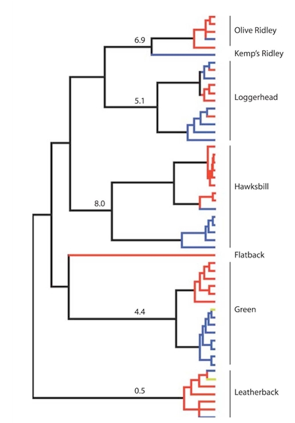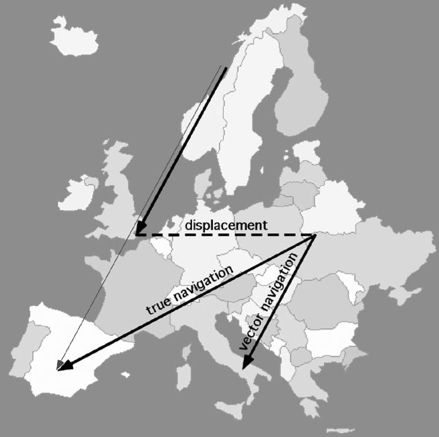Turtle Migration
Biology 342 Fall 2011
Hannah Schaupp, Shelly Skolfield, and Michaela Voorhees
Phylogeny 
There are seven species of turtles. Six of these are in the class Cheloniidae: the olive ridley turtle, Kemp’s ridley turtle, hawksbill turtle, green turtle, loggerhead turtle, and flatback turtle. The leatherback turtle is in the class Dermochelyiidae. [4] To the right is an image of the phylogenetic tree of sea turtles. [4]
The evolution of turtles has been affected by their population structure. Sea turtles migrate to feeding grounds after birth. When they get older all sea turtles demonstrate the behavior of natal homing: they return to the place where they were born to breed and lay eggs. The DNA passed down maternally is consistent in one nesting site, across generations. However, this is not the case for DNA passed down paternally. Males, like females, do exhibit the behavior of natal homing in order to breed. However, evidence from genome comparisons, suggests that mating occurs in feeding areas and migratory pathways where different turtle populations overlap. [4]. Thus the diversity of genes in any one location is maintained by males in the species. The migratory behavior of sea turtles influences the gene flow that shapes evolution.
The behavior of migration is seen across many species including amphibians, crocodiles, fish and birds. Migration is a behavior that requires several evolutionary adaptations to occur. The animal must have a circannual clock in order to know when to migrate, adapt their metabolism to endure a long journey, be able to respond to different conditions within the journey, and be able to navigate to their destination. In the case of birds, the behavior of migration appears to be gained and lost very quickly. Many closely related families of birds include birds that migrate long distances, birds that migrate short distances and birds that don’t migrate at all. [1] This suggests that many of the adaptations necessary for migration may be ancestral traits, common to many different types of animals, that could be latent in species that do not migrate.
Although migration is common among many different types of animals, they use different methods of navigation. Some animals use vector navigation, in which they orient in a certain direction and migrate in that direction until they reach their destination. They are unable to correct their path when they are displaced from their original location. Other animals use landmarks to help them navigate from one place to another. Still others use “true navigation”. In “true navigation” animals are able to determine their position and orient toward their destination correctly after being displaced with no familiar landmarks. [3]

True navigation vs. vector navigation.[3]
Although there is still a lot of debate on this topic, there is substancial evidence that turtles exhibit true navigation using cues from Earth’s magnetic field as a map. [6] The ability to use magnetic cues has been found in other oceanic animals, including lobsters and mollusks.[5] This suggests that the ability to detect and use magnetic cues for orientation would have evolved ancestrally to turtles.